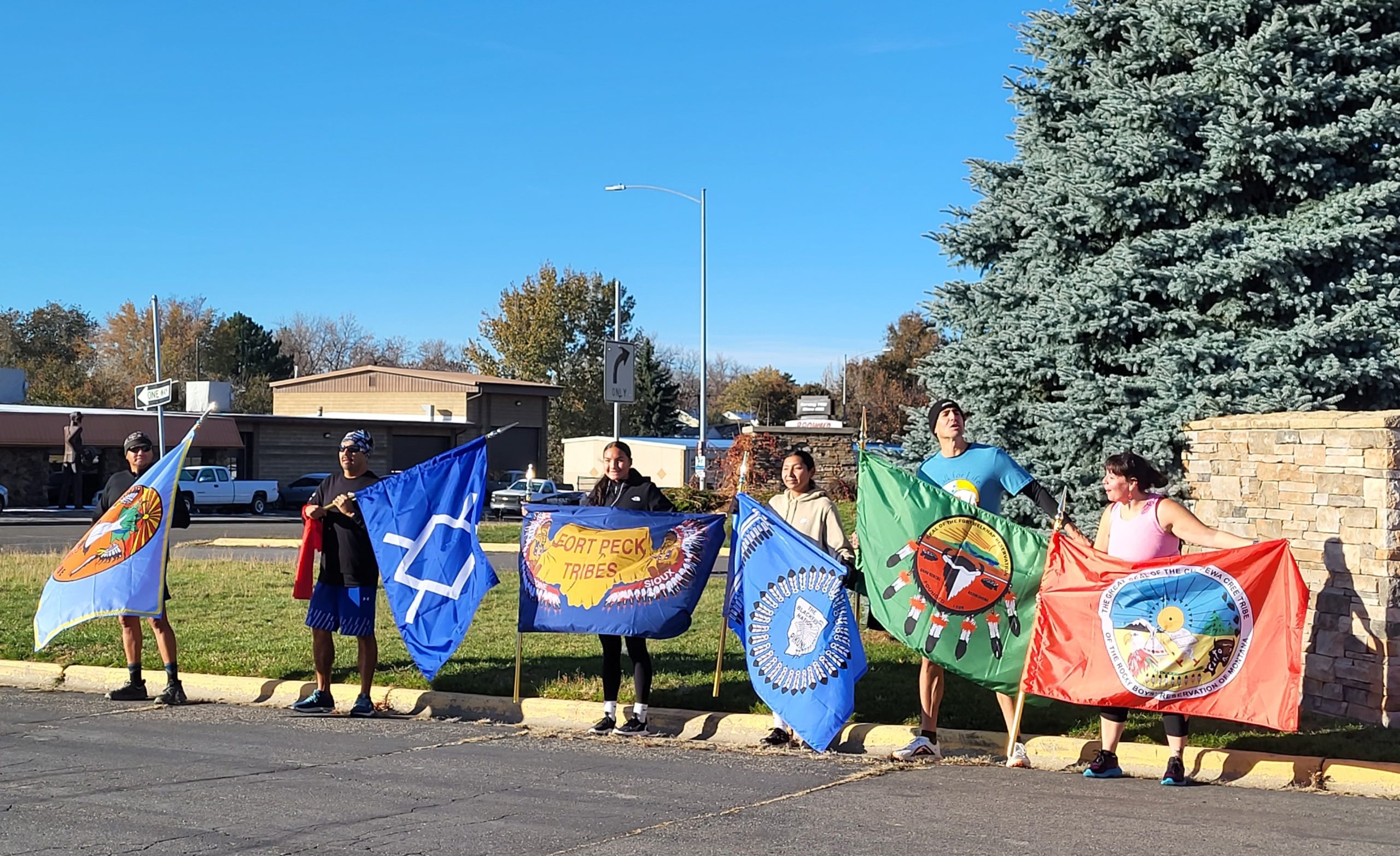Podcast: Play in new window | Download | Embed
The Oglala Sioux Tribe has announced a state of emergency due to increasing crime.
Now, tribal government alleges the federal government is not doing enough to support reservation safety.
South Dakota Public Broadcasting’s C.J. Keene has more.
The declaration was made by Oglala Sioux Tribal government representatives in Rapid City as a result of concerning crime trends over the last few years.
Among the most pressing issues are a murder rate over twice the national average and suicide rates among Native youth that’s well over two-and-a-half-times the average in the rest of the nation.
While the tribe has entered into a mutual aid agreement with regional law enforcement, tribal leaders say the federal government needs to do more.
OST President Frank Star Comes Out says the US government is in violation of the 1868 Fort Laramie Treaty and the Black Hills Act of 1877.
“We don’t live in Indian County, we survive. This needs to change. It’s time to bring awareness to the world that the government has a responsibility to uphold – and that is treaty obligations.”
In multiple treaties dating as far back as 1825, the United States Government is named as a responsible entity in protecting the Oglala Sioux Tribe and its people from “bad men.”
Further, the 1877 Black Hills act formalized the existence of the Pine Ridge Reservation and the cede of the Black Hills to the American government.
That treaty was signed after the “sell or starve” rider cut off all rations to the Sioux people.
Those treaty interpretations led to a lawsuit last year that continues to move through the court system.
This May, a federal judge ruled the federal government does have a treaty obligation to fund tribal law enforcement.
OST Council member Anna Halverson reflected on changes she’d seen.
“I feel like a long time ago we maybe dealt with one homicide, maybe once a month or once a year, and now it’s every day. It’s getting to be very horrendous crimes that are being committed.”
Oglala representatives will send the proclamation to lawmakers in DC to agitate for additional support for reservations.
Additionally, President Star Comes Out says he hopes to speak directly with President Joe Biden soon on the matter.

Courtesy Wisconsin Historical Society Press
A new memoir called SURVIVAL FOOD shares tales from growing up on the Menominee Indian Reservation.
The author, Thomas Weso, was born in 1953. He passed away in July before the book was published.
WUWM’s Lina Tran has more.
Thomas Weso grew up in a time of economic transformation – when commodity goods were eaten alongside game from Wisconsin’s Northwoods. And then there was the rise of processed foods.
He often wrote about food. Here he is speaking in a 2021 interview with Wisconsin Historical Society Press.
“We should think about where food comes from. Because if we think where food comes from, we’ll take better care of the land around us.”
Weso’s wife, the writer Denise Low, says he was interested in writing about Indigenous people in the present.
“He had a very zen sense of like, “What’s here now?” and not “what were Indians like, or Indigenous people like, 100 years ago? Here we are now.”

Courtesy Wisconsin Historical Society Press
That’s why you’ll find all kinds of recipes in the new book, from tamale pie to turtle soup.
There’s instructions on how to forage milkweed pods, which Weso writes are tasty with butter. But he likes mixing them with canned tuna into boxed mac and cheese.
“He doesn’t just stick to Indigenous food. He tries to embrace the diner foods that he loved also. And to accept that there was an intermixture.”
Weso’s taste celebrated that unique mix, found only in Wisconsin, on the Menominee reservation.
Get National Native News delivered to your inbox daily. Sign up for our newsletter today.
 As part of Native American Heritage month, the American Bar Association
As part of Native American Heritage month, the American Bar Association  For Secretary Deb Haaland (Laguna Pueblo), her journey began when she was 28 – a single mom
For Secretary Deb Haaland (Laguna Pueblo), her journey began when she was 28 – a single mom  PBS’ Native America had the last episode of its second season air this week.
PBS’ Native America had the last episode of its second season air this week. This week, a small delegation from the Cherokee Nation attended a U.S. Senate committee hearing on the nomination of Sara Hill to serve as a federal judge in Oklahoma.
This week, a small delegation from the Cherokee Nation attended a U.S. Senate committee hearing on the nomination of Sara Hill to serve as a federal judge in Oklahoma.
 For years, drought and development in the West have caused water shortages for tribes.
For years, drought and development in the West have caused water shortages for tribes. The U.S. Senate passed a bill late Wednesday night to avoid a government shutdown on Friday.
The U.S. Senate passed a bill late Wednesday night to avoid a government shutdown on Friday. More than $9 million has been approved for a project incorporating Native American management practices for oak habitat restoration in Oregon.
More than $9 million has been approved for a project incorporating Native American management practices for oak habitat restoration in Oregon. U.S. Sen. Markwayne Mullin (Cherokee/R-OK) made headlines after a heated confrontation with a witness during a hearing about unions Tuesday in the Health, Education, Labor, and Pensions committee.
U.S. Sen. Markwayne Mullin (Cherokee/R-OK) made headlines after a heated confrontation with a witness during a hearing about unions Tuesday in the Health, Education, Labor, and Pensions committee. Tribal leaders from across the country are gathered in New Orleans for the National Congress of American Indians annual convention where they’re addressing top concerns.
Tribal leaders from across the country are gathered in New Orleans for the National Congress of American Indians annual convention where they’re addressing top concerns. The White House announced Monday that President Joe Biden will host the third annual White House Tribal Nations Summit of his administration on December 6-7.
The White House announced Monday that President Joe Biden will host the third annual White House Tribal Nations Summit of his administration on December 6-7. Meanwhile, tribal leaders from across the country are gathering in New Orleans this week for the National Congress of American Indians annual convention.
Meanwhile, tribal leaders from across the country are gathering in New Orleans this week for the National Congress of American Indians annual convention. Otoe-Missouria Chairman John Shotton is raising concerns about tribal vehicle tags after a recent incident in Oklahoma.
Otoe-Missouria Chairman John Shotton is raising concerns about tribal vehicle tags after a recent incident in Oklahoma. The Shinnecock Indian Nation in New York is hosting a grand opening and ribbon cutting ceremony for Little Beach Harvest Dispensary.
The Shinnecock Indian Nation in New York is hosting a grand opening and ribbon cutting ceremony for Little Beach Harvest Dispensary. The movie adaptation of David Grann’s book Killers of the Flower Moon premiered a few weeks ago.
The movie adaptation of David Grann’s book Killers of the Flower Moon premiered a few weeks ago. U.S. Sen. Lisa Murkowski (R-AK), vice chair of the U.S. Senate Committee on Indian Affairs, is holding a field hearing at Yukon-Kuskokwim Health Corporation in Bethel, Alaska on Friday.
U.S. Sen. Lisa Murkowski (R-AK), vice chair of the U.S. Senate Committee on Indian Affairs, is holding a field hearing at Yukon-Kuskokwim Health Corporation in Bethel, Alaska on Friday. The Native American Development Council in Montana is hosting events for Native American Heritage Month.
The Native American Development Council in Montana is hosting events for Native American Heritage Month. The fourth season of the show Native Shorts, which airs on FNX TV and is presented by Sundance Institute’s Indigenous Films program, is now in production.
The fourth season of the show Native Shorts, which airs on FNX TV and is presented by Sundance Institute’s Indigenous Films program, is now in production.
 Wilma Mankiller is the newest addition to the Barbie Inspiring Women series.
Wilma Mankiller is the newest addition to the Barbie Inspiring Women series.